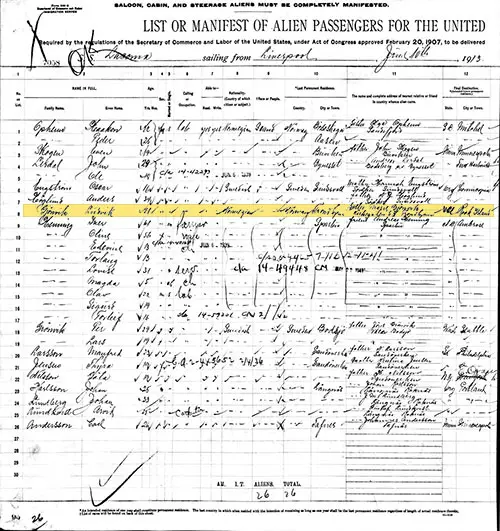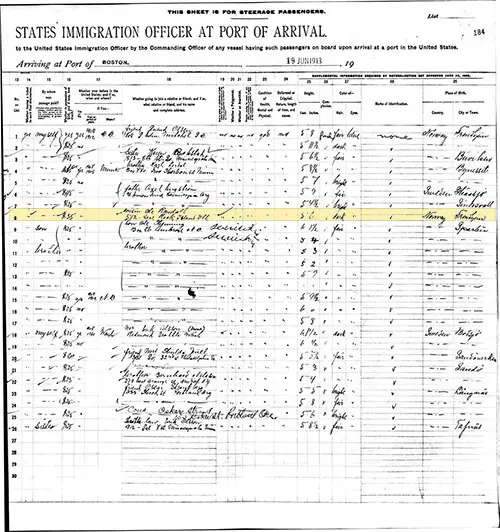🚢 RMS Laconia 1913: A Norwegian Immigrant’s Journey from Trondheim to Boston 🇳🇴➡️🇺🇸
📌 Discover the 1913 Third-Class passage contract of Norwegian immigrant Ludvig Kristian Gjønvik aboard the RMS Laconia. This document sheds light on transatlantic migration, Norwegian emigration, and early 20th-century ocean travel. 🌊📜
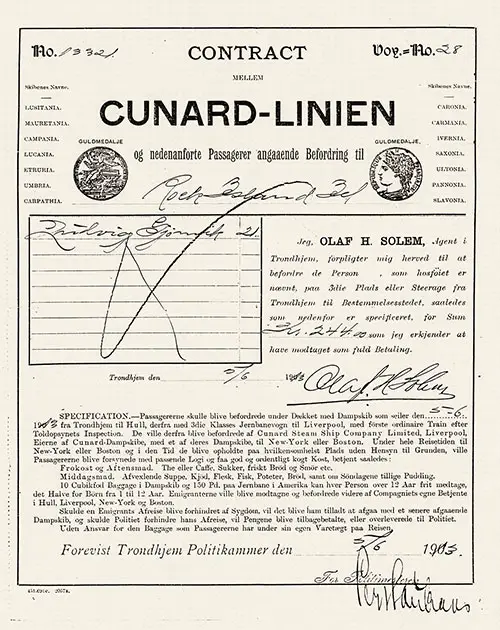
Norwegian Immigrant Third-Class Steerage Contract for Passage From Trondhjem to New York or Boston - 5 June 1913. | GGA Image ID # 1e9d6ef5cf
Summary of Passage Contract
- Date of Purchase / Voyage: 5 June 1913
- Steamship Line: Cunard Line
- Steamship: RMS Laconia
- Route: Trondhjem to Boston via Hull and Liverpool
- Ticket Type: Passage Contract
- Voyage Class: Third class or Steerage
- Name on Contract: Ludvig Kristian Gjønvik
- Etnicity of Passenger(s): Norwegian
- Contract Terms: Translated from Norwegian
- Cost of Ticket: 244.00 NOK / $1,690.00 USD in 2020
Passage Contract Details 📢
Ludvig Gjønvik was a Norwegian Immigrant to the United States in June 1913, arriving in Boston on board the RMS Laconia (I) as a passenger in Steerage - Third Class. Ludvig purchased This contract of passage from Olaf H. Solem, the Agent for the Cunard Line in Trondheim, Norway.
Ludvig was booked on the Wilson Line Aaro that took him from Trondhjem to Hull, England. He then took a train from Hull to Liverpool, where he boarded the Cunard Ship Laconia on 10 June 1913 for the transatlantic portion of his Journey, arriving at the Port of Boston on 19 June 1913.
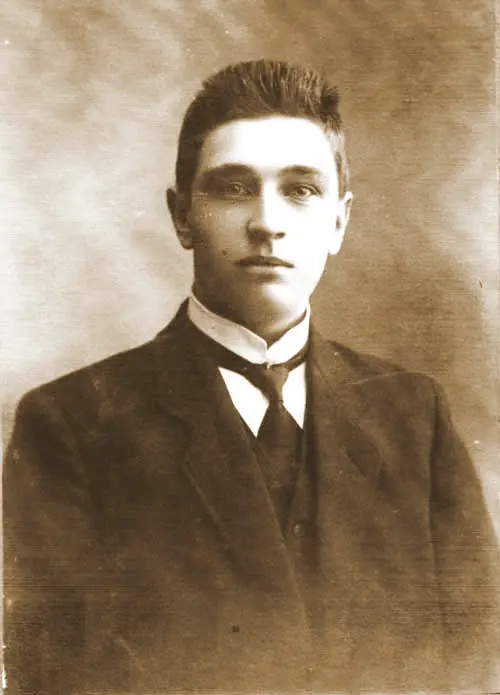
Norwegian Immigrant, Ludvig Kristian Gjønvik from Trondheim Norway. Photo circa 1912 (~20 Years Old). | GGA Image ID # 1e9d979676
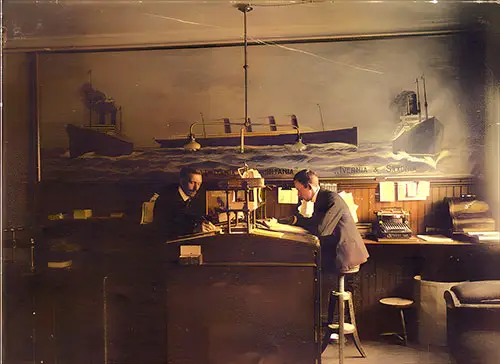
The Olaf H. Solem Cunard Line Steamship Company Agency in Trondheim, Norway circa 1910. Olaf H. Solem is pictured above on the left. Photo courtesy of Børge Solem. | GGA Image ID # 14c7bcc2e7
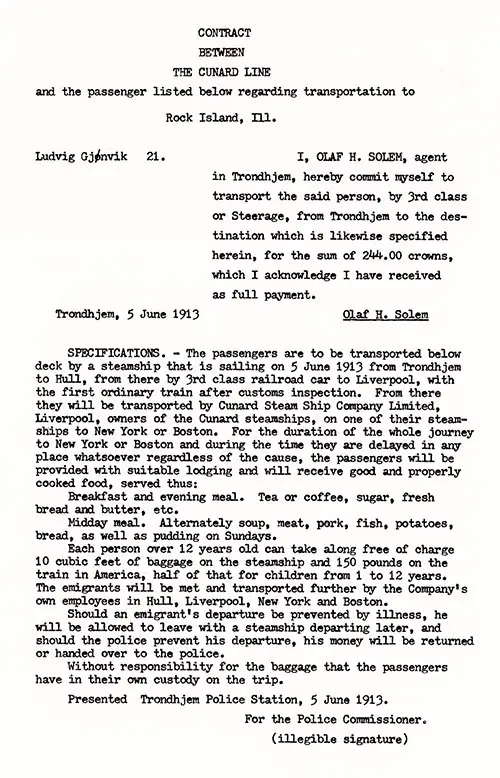
Translation of the Norwegian Text of the RMS Laconia Passage Contract, 5 June 1913. | GGA Image ID # 1fa7cc2c1a
CONTRACT
Between
THE CUNARD LINE
And the passenger listed below regarding transportation to
Rock Island, Ill.
I, OLAF H. SOLEM, agent in Trondhjem, hereby commit myself to transport the said person, by 3rd class or Steerage, from Trondhjem to the destination which is likewise specified herein, for the sum of 244.00 crowns, which I acknowledge I have received as full payment.
/s/ Olaf H. Solem
Trondhjem, 5 June 1913
Specifications - The passengers are to be transported below deck by a steamship that is sailing on 5 June 1913 from Trondhjem to Hull, from there by 3rd class railroad car to Liverpool, with the first ordinary train after customs inspection. From there they will be transported by Cunard Steam Ship Company Limited, Liverpool, owners of the Cunard steamships, on one of their steam-ships to New York or Boston. For the duration of the whole journey to New York or Boston and during the time they are delayed in any place whatsoever regardless of the cause, the passengers will be provided with suitable lodging and will receive good and properly cooked food, served thus:
- Breakfast and evening meal. Tea or coffee, sugar, fresh bread and butter, etc.
- Midday Meal. Alternately soup, meat, pork, fish, potatoes, bread, as well as pudding on Sundays.
Each person over 12 years old can take along free of charge 10 cubic feet of baggage on the steamship and 150 pounds on the train in America, half of that for children from 1 to 12 years. The emigrants will be met and transported further by the Company' s own employees in Hull, Liverpool, New York and Boston.
Should an emigrant's departure be prevented by illness, he will be allowed to leave with a steamship departing later, and should the police prevent his departure, his money will be returned or handed over to the police.
Without responsibility for the baggage that the passengers have in their own custody on the trip.
Presented Trondhjem Police Station, 5 June 1913. (Note 1)
For the Police Commissioner.
(illegible signature)
Børge Solem and I first corresponded in 2000, when I purchased some items for the Gjenvick-Gjønvik Archives from him. It turned out that he was the great-grandson of Olaf H. Solem who had sold the ticket to my grandfather in 1913. This would have been the office of the Cunard Steamship Line Trondhjem agency, The Cunard Steam Ship Co., Ltd. (Olaf H. Solem) located on Søndre Gate 26, Trondhjem, Norge.
Note 1: Norwegian Emigrants were required to register with the Police. See the Norwegian Emigration Law of 1867
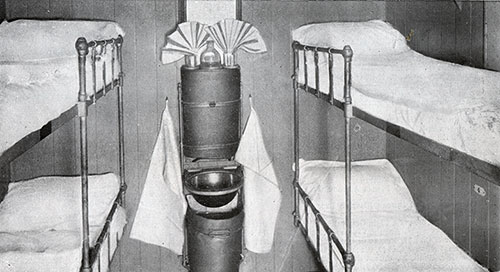
Third Class / Steerage Four-Berth Room on the RMS Franconia and RMS Laconia. Fanconia and Laconia Brochure, 1912. | GGA Image ID # 118805de77
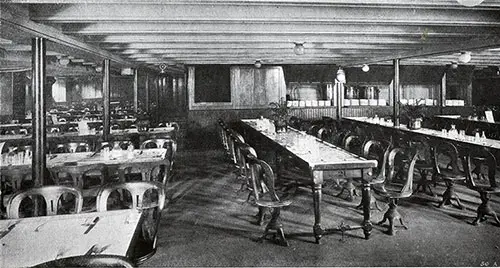
Third Class / Steerage Dining Room on the RMS Franconia and RMS Laconia. Fanconia and Laconia Brochure, 1912. | GGA Image ID # 11885a4643
Arrival Records
List or Manifest of Alien Passengers for the United States Immigration Officer at Port of Arrival
Steerage Passenger Manifest, RMS Laconia of the Cunard Line, From Liverpool to Boston Arriving 19 June 1913. List 184 Left. Ludvig Gjønvik Appears on Line 8. | GGA Image ID # 1a1d7d7b42
Steerage Passenger Manifest, RMS Laconia of the Cunard Line, From Liverpool to Boston Arriving 19 June 1913. List 184 Right. Ludvig Gjønvik Appears on Line 8. | GGA Image ID # 1a1dfcee60
Relative Cost of Passage Ticket in Today's Currency Value
The first section converts NOK of 1913 to NOK in 2021 and converting the 1921 NOK to USD. A second option was to locate the actual exchage rate in 1913. 1914 was the closest found. The rate did not change materially betwen 1913 and 1914. The second section takes the 1914 equivalent in USD $63.21 and determines the current value as of 2021.
244.00 NOK in 1913 is equal to 14,909.68 NOK in 2021 based on a 6,010.5% increase in the Consumer Price Index.
Source: https://www.ssb.no/en/priser-og-prisindekser/konsumpriser/statistikk/konsumprisindeksen
14,909.68 NOK in 2021 is equal to 1,727.778 USD using the average for 2021 of 0.115883 NOK to $1 exchange rate.
Source: https://www.investing.com/currencies/nok-usd-historical-data
September 1914 NOK Exchange Rate averaged 3.860 NOK to $1.00 USD. There was little movement in the CPI for Norway between 1913 and 1914 per https://www.ssb.no/en/priser-og-prisindekser/konsumpriser/statistikk/konsumprisindeksen.
244 / 3.860 = $63.21 USD in 1914
In 2020, the relative values of $63.21 from 1914 ranges from $1,230.00 to $35,900.00.
A simple Purchasing Power Calculator would say the relative value is $1,690.00. This answer is obtained by multiplying $63.21 by the percentage increase in the CPI from 1914 to 2020.
This may not be the best answer.
The best measure of the relative value over time depends on if you are interested in comparing the cost or value of a Commodity, Income or Wealth, or a Project.
If you want to compare the value of a $63.21 Commodity in 1914 there are four choices. In 2020 the relative:
- real price of that commodity is $1,690.00
- real value in consumption of that commodity is $3,460.00
- labor value of that commodity is $8,250.00 (using the unskilled wage) or $10,300.00 (using production worker compensation)
- income value of that commodity is $10,800.00
- economic share of that commodity is $35,900.00
If you want to compare the value of a $63.21 Income or Wealth, in 1914 there are five choices. In 2020 the relative:
- real wage or real wealth value of that income or wealth is $1,690.00
- household purchasing power value of that income or wealth is $3,460.00
- relative labor earnings of that commodity are $8,250.00 (using the unskilled wage) or $10,300.00 (using production worker compensation)
- relative income value of that income or wealth is $10,800.00
- relative output value of that income or wealth is $35,900.00
If you want to compare the value of a $63.21 Project in 1914 there are four choices. In 2020 the relative:
- real cost of that project is $1,230.00
- household cost of that project is $3,460.00
- labor cost of that project is $8,250.00 (using the unskilled wage) or $10,300.00 (using production worker compensation)
- relative cost of that project is $10,800.00
- economy cost of that project is $35,900.00
A Special Note About the Ticket
The Ticket Cost of 244.00 NOK or USD $63.21 in 1913 covers the voyage from Trondheim to Hull, England, a thrid-class rail ticket from Hull to Liverpool, and the voyage on the Cunard RMS Laconia from Liverpool to Boston. Unfortunately, there wasn't a breakdown of fares for each part of the journey.
Fortunately, we know that the Liverpool to Boston portion cost $35 (Ocean Fare from Mary Ellen McGuire's Ticket on Same Voyage). The first two legs of his journey from Trondheim to Liverpool via Hull and the train from Boston to would have cost $28.21.
🚢 RMS Laconia Passage Contract – A Norwegian Immigrant’s Journey to America, 5 June 1913
🌍 A Personal & Historical Voyage from Norway to the United States
The RMS Laconia Passage Contract from 5 June 1913 is a remarkable artifact documenting the third-class voyage of Norwegian immigrant Ludvig Kristian Gjønvik from Trondhjem (Trondheim), Norway, to Boston, USA. This contract is not just a legal document but a powerful representation of transatlantic migration, the immigrant experience, and the financial commitment required for such a life-changing journey.
What makes this contract even more special is its deep connection to the Gjenvick-Gjønvik Archives. Ludvig Gjønvik, the grandfather of the GG Archives’ founder, was a passenger on this very voyage. His journey, like that of many immigrants, reflects the dreams, challenges, and sacrifices of those seeking a new life in America.
🔍 Why This Passage Contract is Historically Significant
This passage contract is an essential primary source artifact, making it highly valuable for:
📖 Teachers & Students: Exploring early 20th-century immigration and transatlantic travel.
📜 Genealogists: Connecting families to their immigrant ancestors through passenger records.
🏛️ Historians: Understanding the role of prepaid migration, travel logistics, and immigrant sponsorship.
🚢 Maritime Enthusiasts: Studying third-class travel aboard Cunard Line steamships.
📌 Key Details from the Passage Contract
📆 Date & Route:
Ticket Purchased: 5 June 1913
Voyage Departure: 10 June 1913
Route: Trondhjem (Trondheim) → Hull (UK) → Liverpool → Boston (USA)
Ship: RMS Laconia (Cunard Line)
Class: Third-Class (Steerage)
👤 Passenger & Ticket Information:
Name: Ludvig Kristian Gjønvik
Age: ~21
Ethnicity: Norwegian
Destination: Rock Island, Illinois (final destination in the U.S.)
Ticket Cost: 244.00 NOK (Norwegian Kroner) $63.21 USD in 1914 / Equivalent to $1,690.00 in today’s USD
Ticket Purchased From: Olaf H. Solem, Cunard Line Agent in Trondheim, Norway
🔹 Fascinating Historical Connection:
The GG Archives has a unique link to this ticket—decades later, the grandson of Ludvig Gjønvik founded the Gjenvick-Gjønvik Archives, preserving thousands of maritime and immigration documents.
🖼️ Noteworthy Images & Their Importance
📜 RMS Laconia Third-Class Steerage Contract
📌 This passage contract, written in Norwegian, details Ludvig Gjønvik’s journey and travel conditions.
📷 Norwegian Immigrant, Ludvig Kristian Gjønvik (Circa 1912, Age 20)
📌 A rare portrait of Ludvig before his voyage—capturing the face of a young immigrant about to embark on a new life in America.
🏛 Olaf H. Solem Cunard Line Agency in Trondheim, Norway (Circa 1910)
📌 This image showcases the office of Olaf H. Solem, the man who sold Ludvig’s ticket to America.
📌 Incredible Family Connection:
Decades later, the GG Archives’ founder connected with Olaf H. Solem’s great-grandson, Børge Solem, making this an even more personal and meaningful artifact in immigration history.
🛏️ Third-Class / Steerage Four-Berth Room on the RMS Franconia and RMS Laconia (1912)
📌 This image provides a rare glimpse into the accommodations for third-class passengers aboard the RMS Laconia. Unlike first and second-class travelers, steerage passengers shared small, compact rooms with limited privacy. The four-berth setup, though basic, reflects improved conditions compared to earlier steerage quarters, which often consisted of large communal sleeping areas.
📌 Significance:
Shows the realities of immigrant travel—crowded yet functional spaces designed for affordability over comfort.
Illustrates the difference in class-based accommodations on transatlantic voyages.
Essential for genealogy and historical studies, helping descendants visualize their ancestors’ journey to America.
🍽️ Third-Class / Steerage Dining Room on the RMS Franconia and RMS Laconia (1912)
📌 This image showcases the dining arrangements for third-class passengers on the RMS Laconia, highlighting long communal tables where immigrants gathered for meals. While simple, this setting was a notable improvement over earlier ships where steerage passengers had to bring their own food.
📌 Significance:
Reflects the evolving standards for steerage class travel, as steamship companies began offering structured meal services to third-class passengers.
Highlights the shared experience of immigrants, as dining halls were among the few social spaces available to steerage travelers.
Offers a connection to historical accounts—many immigrants later recalled these communal meals as an introduction to the diverse cultures of fellow travelers.
These images provide a more immersive understanding of what life was like aboard the RMS Laconia for third-class passengers like Ludvig Gjønvik and Mary Ellen McGuire, making their journey even more tangible and relatable for historians, genealogists, and educators. 🚢🌍📜
💰 The Cost of Passage in 1913 vs. Today
While 244 NOK may seem like a small amount, it was a significant financial commitment for an immigrant. When adjusted for inflation:
💰 Economic Context of the Fare in 2020 Terms:
Purchasing Power Equivalent: $1,690
Labor Value Equivalent: $8,250 (Unskilled wage) or $10,300 (Skilled labor)
Relative Economic Share: $35,900
📌 Insight: Even third-class travel was a substantial expense, often requiring family sponsorship, loans, or years of savings.
🌊 The Immigrant Experience in Third-Class Travel
Traveling in third-class (steerage) was an endurance test, but it offered immigrants an opportunity for a better future. Ludvig’s journey included:
🚶♂️ Multiple Modes of Transport:
Steamship from Trondheim to Hull, UK (Wilson Line’s Aaro).
Train from Hull to Liverpool.
Cunard Line voyage from Liverpool to Boston.
🍽️ Basic Meals Provided:
Tea, coffee, fresh bread, butter.
Soup, meat, fish, potatoes, pudding on Sundays.
🏠 Baggage Allowance:
10 cubic feet per adult.
150 lbs on the train in America.
📌 Harsh Reality: Conditions in steerage class were cramped, unsanitary, and physically exhausting, but it was the most affordable way to travel for working-class immigrants.
📜 The GG Archives Connection: A Shared Voyage with Mary Ellen McGuire
Ludvig wasn’t the only immigrant on this voyage with a lasting legacy.
🔹 Mary Ellen McGuire, a 20-year-old Irish immigrant, also traveled third class aboard the same RMS Laconia voyage from Liverpool to Boston.
📌 What’s remarkable?
Both Ludvig and Mary Ellen were young immigrants seeking a new life in America.
Mary’s ticket was prepaid by a relative in the U.S., a common occurrence for many immigrants.
The GG Archives now preserves both Ludvig’s and Mary Ellen’s passage records—creating a lasting historical connection.
🌎 These shared experiences highlight the universal immigrant story—hope, uncertainty, and resilience.
🏛 Broader Historical & Genealogical Significance
🔎 For Genealogists
This passage contract serves as a vital ancestral record, linking Norwegian immigrants to ship manifests and census data.
The sponsorship details help trace family connections in both Norway and America.
🏛️ For Historians
The contract demonstrates how European immigrants booked transatlantic passage, often through prepaid or agent-assisted arrangements.
It highlights Norway’s role in global migration and the importance of shipping lines like Cunard in mass emigration.
🔮 Final Thoughts: A Voyage into History
The RMS Laconia Third-Class Passage Contract from 5 June 1913 is more than just a historical document—it’s a personal story, a family legacy, and a testament to the immigrant experience.
📜 For historians, genealogists, and educators, this contract serves as a crucial artifact, offering insights into immigration, maritime history, and family connections.
🚢 Whether tracing family roots or studying migration history, this passage contract is a priceless window into the lives of those who braved the Atlantic for a brighter future! 🌍✨

